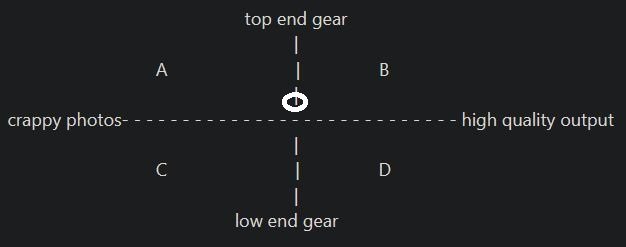Archiver
Veteran
A post in the thread about being 'stuck in a hole' and the tangent of whether gear matters prompted this visualization of gear vs output:
 rangefinderforum.com
rangefinderforum.com
On the other side of the spectrum, there are any number of gear-obsessed button pushers who produce the most banal and uninspiring work (cough YouTube cough).
Other professionals have basic Canon and Nikon DSLR's but produce excellent work, because they maximize their output through an understanding of the capabilities and limitations of their gear. And there are combinations of gear/output all along this spectrum. You could even think of this is a four axis graph:
(I hope this quadrant chart formats properly!)
(edited to add: this chart didn't format properly, so I'm embedding a screenshot)
Quadrant A represents where people with decent gear produce bad work, which includes many gear obsessed hobbyists, and well monied but uninspired professionals.
Quadrant B is where money/resources meets talent, skill and hard work.
Quadrant C is where a lot of beginners start, then they move into other quadrants. Some move to QA if they buy better gear but don't upgrade their skill. Some stick with their lower end gear, either through preference or necessity, but move to QD because they refine their eye, shot selection and processing. People can move into QD when they get better gear and skills.
Quadrant D is where a person with a Canon Rebel shoots fashion for local magazines, a Yashica point and shoot owner creates art, and where a smartphone user emotively and accurately documents a warzone.
Where do we think our work lies these days? For me, I move between QA and QB. I have decent gear, not the best, but decent. I take a lot of bad photos, but I can reliably produce decent ones when the need is there. How about you fine folk?

Stuck In A Hole - How to find enjoyment in actually taking photos?
I could never ignite my love for Photography by using a Sony, nor ignite my love for driving by driving a Hyundai Sonata. A lot of us here are fortunate to be able to choose to not use a Sony, or whatever the equivalent of driving a Hyundai Sonata is. The point that I'm getting at is that if...
 rangefinderforum.com
rangefinderforum.com
I've met fine art photographers who use medium format cameras like the Rolleiflex, but if you ask them about gear, they can't tell you a thing. They just found a medium they liked, and stuck with it.A lot of us here are fortunate to be able to choose to not use a Sony, or whatever the equivalent of driving a Hyundai Sonata is.
The point that I'm getting at is that if your passion for photography is so great—the actual act of taking, printing, and looking at photographs—then whatever tool you have will be good enough to use to express the creative impulse inside of you, and if done passionately and with dedication, that can no doubt lead to something great and worth doing.
I don't understand the bitterness or why you seem to think I'm taking a jab at you or something. I'm simply stating that there is a spectrum where on one end all the care and obsession goes into the output and on the other the obsession goes into the object used to make the thing. My guess is that at a certain point if you skew too far to the object end the likelihood of making something boring and rote with that object is high.
30k darkroom prints? That's cool. A good silver gelatin print is a beautiful object. But a boring photograph, even if printed well on silver paper, is a boring photograph.
Look at Jeff Mermelstein. Made outstanding and interesting work with a Leica. Then made extremely interesting work with an iPhone in his book #nyc.
On the other side of the spectrum, there are any number of gear-obsessed button pushers who produce the most banal and uninspiring work (cough YouTube cough).
Other professionals have basic Canon and Nikon DSLR's but produce excellent work, because they maximize their output through an understanding of the capabilities and limitations of their gear. And there are combinations of gear/output all along this spectrum. You could even think of this is a four axis graph:
(I hope this quadrant chart formats properly!)
(edited to add: this chart didn't format properly, so I'm embedding a screenshot)
Quadrant A represents where people with decent gear produce bad work, which includes many gear obsessed hobbyists, and well monied but uninspired professionals.
Quadrant B is where money/resources meets talent, skill and hard work.
Quadrant C is where a lot of beginners start, then they move into other quadrants. Some move to QA if they buy better gear but don't upgrade their skill. Some stick with their lower end gear, either through preference or necessity, but move to QD because they refine their eye, shot selection and processing. People can move into QD when they get better gear and skills.
Quadrant D is where a person with a Canon Rebel shoots fashion for local magazines, a Yashica point and shoot owner creates art, and where a smartphone user emotively and accurately documents a warzone.
Where do we think our work lies these days? For me, I move between QA and QB. I have decent gear, not the best, but decent. I take a lot of bad photos, but I can reliably produce decent ones when the need is there. How about you fine folk?

Last edited:



